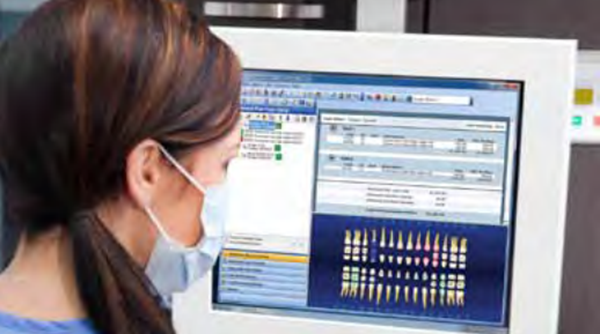Multi-codes make scheduling, charting, and treatment planning faster and easier.
Updated 11/10/21
Did you know that Dentrix multi-codes can help you maximize your efficiency as you schedule, chart, plan, and post treatment?
Some treatments, even common ones such as an adult’s periodic exam, consist of several procedures. Multi-codes save you time by letting you group up to eight procedure codes in a single multi-code. So, rather than entering all the procedure codes for a periodic exam separately, you can enter the codes simultaneously using a single multi-code. For your convenience, Dentrix includes several pre-defined multi-codes, but you can easily edit these multi-codes or create your own.
To create a multi-code, from the Maintenance menu in the Office Manager, point to Practice Setup, and then click Multi-Code Setup. Click New in the Multi-Code Setup dialog box.

From the Multi-Code Editor dialog box, type a description of the multi-code that you are creating, the code number you want to use for your custom multi-code, and an abbreviated description. Next, select an appointment type and a procedure type. Dentrix inserts a procedure time automatically as you add procedure codes. Click Add and type or select the procedure codes that you want to include in your multi-code. Depending on the procedure codes that you select, Dentrix requires you to specify the surface, quadrant, and/or sextant. If the procedure requires a tooth number or range, you can supply this information when you post the procedure in the Patient Chart or the Ledger.
Once you’ve set up a multi-code, you can use it just as you would a procedure code.
Scheduling
You can speed up your scheduling using multi-codes. In the Appointment Book, for example, if you were scheduling an adult patient’s periodic exam that included a prophy, four bitewings, and an evaluation, you could post three procedure codes or just use the one predefined multi-code for an adult prophy. To use this multi-code when scheduling an appointment, from the Appointment Information dialog box, click Misc. Under Category, select Multi-Codes. Select xxCCA and click OK.
Tip: You may want to edit the CCA multi-code in the Office Manager to include fluoride and oral hygiene instructions.
For a procedure requiring additional information, such as a tooth number or range, you must specify this information in the Patient Chart or the Ledger and then treatment plan the procedure before scheduling the appointment; otherwise, you cannot set the procedure complete.
Charting
After creating a multi-code, you could create a procedure button in the Patient Chart and assign the multi-code to it. To do this, from the Setup menu, click Procedure Buttons Setup. Click New. Under Procedure, expand Multi-Codes and select the multi-code that you want to use, such as xxCCA. Under Select Button Face, select Use Image or Use Code Text and then select an image or a font, respectively. Click OK, and then click Close.
Now charting a patient’s treatment is as simple as a mouse click, and since there is no limit to the number of procedure buttons you can create, with a little time and thought, you can create any number of multi-codes and assign them to procedure buttons to make your charting fast, efficient, and consistent. Once you click the Completed button in the Patient Chart, Dentrix automatically posts the completed work to the Ledger, and you’re ready to bill.
Treatment Planning
Treatment planning is easier using multi-codes too, especially since you can “bundle” several multi-codes to create other even more comprehensive multi-codes.
For example, since some treatments, such as partials or orthodontia, require several follow-up visits over an extended period, you can create and use bundled multi-codes to create treatment plans for them. To treatment plan monthly orthodontia visits, first, create a periodic ortho exam multi-code named xx801 using PerOrtho as the abbreviated description. Add the D8670 Periodic Orthodontic Treatment procedure code eight times to this multi-code.

Set up two more multi-codes following the same pattern as the first, but naming these multi-codes xx802 and xx803 and using PerOrtho2 and PerOrtho3 for the abbreviated descriptions, respectively.
Next, set up a fourth multi-code for the full case and name it xx800. Add the xx801, xx802, and xx803 multi-codes to the full case multi-code. The full case orthodontia multi-code now contains 24 monthly visits to which you can add up to five other procedures, such as records appointments and retainers. Once the full case multi-code is complete, you can use it to treatment plan two years of orthodontia with a single code.
Multi-codes are very versatile and allow you to get as creative as you like. Because the Dentrix modules are so highly integrated, you can use multi-codes wherever procedure codes are used in Dentrix. Simplify the task of scheduling, charting, billing, and treatment planning using multi-codes–you may be surprised at how much time you’ll save.
Learn More
To learn more about creating multi-codes, see the Multi-code Setup topic in Dentrix Help.
For other charting tips, read A Patient Charting Primer.
Visit https://www.dentrix.com/solutions/clinical-efficiency for more ideas about improving your clinical efficiency with Dentrix.
By Gary Frazier, Contributing Editor
Originally published in Dentrix Magazine, Spring 2012





